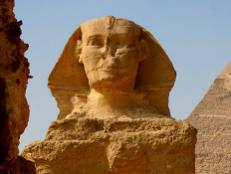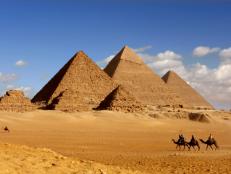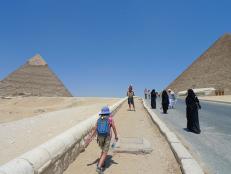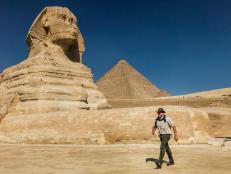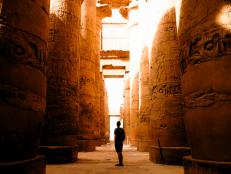Seven Wonders of Egypt
Egypt is famous for its ancient civilization. It's also a top destination for some of the world's most famous sights and monuments. Get the scoop on the seven wonders of Egypt.
Related To:
lessRelated To:
View The Gallery
1 / 7
Pyramids of Giza
The Great Pyramid of Giza is the oldest and largest of the three pyramids in the Giza Necropolis bordering Cairo, Egypt. It is the only remaining member of the Seven Wonders of the World and is believed to have been built as a tomb for Fourth Dynasty Egyptian Pharaoh Khufu, constructed over a 20 year period concluding around 2560 BC. The Great Pyramid is the main part of a complex or set of buildings that include two mortuary temples in honor of Khufu. There are also three smaller pyramids for Khufu's wives.
Temple of Luxor
The Luxor Temple was dedicated to the Theban Triad of Amun-Re, his wife Mut, and his son Khonsu. The large ancient Egyptian temple complex is located on the east bank of the Nile River in the city once known as Thebes, but today it is known as Luxor. For the ancient Egyptians and modern tourists, access to the temple is granted from the north, where a path lined by sphinxes once led all the way to Ipet Sut in modern city of Al-Karnak.
The Great Sphinx
The Great Sphinx of Giza is a large half-human, half-lion statue in Egypt, on the Giza Plateau at the west bank of the Nile River near Cairo. The commonly used name "Sphinx" was given to it based on the Greek creature with the body of a lion, the head of a woman and the wings of an eagle, though this sphinx have the head of a man. It is one of the largest single-stone statues on Earth, and is commonly believed to have been built by ancient Egyptians in the 3rd millennium BC.
Cairo
Cairo, which means "The Vanquisher or "The Triumphant", is the capital city of Egypt. Old Cairo was founded in 648 AD near other Egyptian cities and villages, including the old Egyptian capital Memphis, Heliopolis, Giza and the Byzantine fortress of Babylon in Egypt. Today, Greater Cairo encompasses various historic towns and modern districts. A journey through Cairo is a virtual time travel: from the Pyramids, Saladin's Citadel, the Virgin Mary's Tree, the Sphinx, Al-Azhar (the Mosque of Amr ibn al-A'as), Saqqara, the Hanging Church, and the Cairo Tower.
Abu Simbel
The archaeological site is comprised of two massive rock temples that were originally carved out of the mountainside during the reign of Pharaoh Ramesses II in the 13th century BC, as a lasting monument to himself and his Queen Nefertari. The Great Temple at Abu Simbel took about 20 years to build and after its completion, it was dedicated to the gods Amun Ra, Ra Harakhti, and Ptah, as well as the deified Ramesses himself.
Temple of Karnak
The largest ancient religious site in the world, the Temple of Karnak is a vast open-air museum and is probably the second most visited historical site in Egypt, second only to the Giza Pyramids. It consists of four main parts, of which only the largest temple -- The Precinct of Amon-Re -- is accessible by tourists and the general public. The key difference between Karnak and Egypt's other temples is that construction occurred over a vast amount of time; approximately 30 pharaohs contributed to the buildings, enabling it to reach a size, complexity and diversity not seen elsewhere.
Saqqara
Located about 30 km south of Cairo, Saqqara or Sakkara is a vast, ancient burial ground in Egypt, featuring the world's oldest standing step pyramid. While Memphis was the capital of Ancient Egypt; Saqqara served as its cemetery. Although the earliest burials of nobles at Saqqara can be traced back to the First Dynasty, it was not until the Second Dynasty that the first kings were buried there, including Hotepsekhemwy and Nynetjer.
